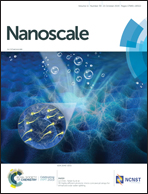Modulation of oxygen vacancy in tungsten oxide nanosheets for Vis-NIR light-enhanced electrocatalytic hydrogen production and anticancer photothermal therapy†
Abstract
Oxygen vacancy (OV) tuning was introduced into oxygen-deficient WO3 nanosheets to optimize the chemical and electronic properties. Enhanced electronic conduction, extended light absorption, enhanced HER reaction kinetics and benign photothermal performance were verified by density functional theory (DFT) calculations and experimental studies. Vis-NIR light-enhanced electrocatalytic HER was accomplished with a small overpotential of 52 mV (at 10 mA cm−2) and a low Tafel slope of 37 mV dec−1 and performed much more efficiently than that in darkness, comparable to the noble-metal catalysts (Pt, Pt/C). Moreover, the resultant WO3–OVs possess good photothermal conversion efficiency. The promising potential of the WO3–OVs for anticancer photothermal therapy has been demonstrated with a high photothermal conversion efficiency (∼41.6%) upon single wavelength near-infrared irradiation and an efficient tumor inhibition rate (∼96.8%). This design of photoelectronic/thermal materials paves an exciting new avenue for the conversion of well-developed metal oxides to be high-performance and multifunctional materials for energy and oncology applications.



 Please wait while we load your content...
Please wait while we load your content...